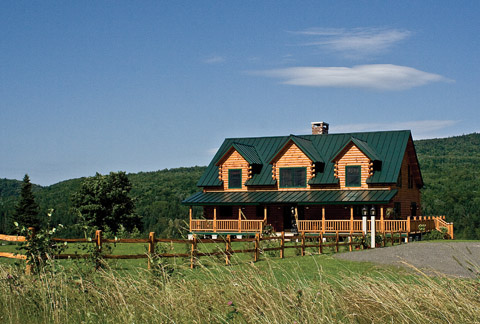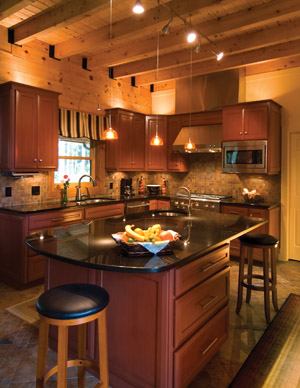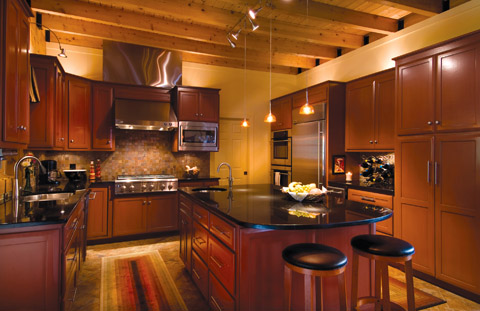The year 2011 will be critical for housing. It’s no secret that increases in unemployment claims and foreclosures have caused the economy to tumble over the latter half of the past decade, and housing, particularly new-construction starts, has endured the disconcerting aftermath of a lack of consumer confidence. However, the fourth quarter of 2010 brought with it a slight shift in the economic outlook, and, perhaps, hope. “We all recognize that over the past several years, the housing market has been flat, at best, across the board,” says Greg Grimes, a partner with Expedition Log Homes in Oostburg, Wisconsin. But Greg sees an improved sense of optimism and faith in the economic future. “At Expedition, we finished strong in 2010, and it’s carrying over into 2011. A lot of factors came together to make that happen. It feels like the ship is finally righting itself,” he says.
These sentiments of renewing confidence, signs of movement in the housing market, and small indications of economic recovery mean one thing: There’s never been a better time to buy your dream log cabin home than right now. And there are a host of reasons why.
First, following the crash of the general housing marketing in 2007, buyers have been hesitant to part with their hard-earned money, and as a result, consumer demand for log homes has slowed over the past three to four years. Greg says, “Most log home producers don’t have the huge backlog of orders to fill as they did in 2005-2006, freeing them up to turn homes around rapidly.” Dana Delano, director of sales and marketing for Houlton, Maine-based Ward Cedar Log Homes, agrees. “Consumers aren’t seeing the long lead times that they were subjected to during the housing boom,” he says. “Homes can be milled and shipped a lot faster these days.” This could be a vital piece of good news for you, as financial institutions are more apt to approve construction loans for homes that can be completed and converted to conventional mortgages in an expedient time frame.
“If you are a credit-worthy borrower, there’s money to be had,” says Jim Banner, general manager at PrecisionCraft Log & Timber Homes in Meridian, Idaho, whose company also witnessed an upswing in demand during the fourth quarter of last year. “The loan application process is more stringent and banks may require a larger down payment than they did in the mid-2000s, but loans are still being doled out.” Greg adds, “Even if you have to jump through hoops, financing is still very available. Don’t miss your window of opportunity.”
And money is cheap right now. Interest rates are still at historic lows, but economists warn that with all the money the government has been pumping into the economy, there’s a strong risk of inflation over the next 12 to 36 months, which will drive up rates and make products and services increasingly more expensive. “The smart buyer will get in early, because eventually, log home package costs and builders’ fees are going to rise. If you believe the economy is starting to swing in a positive direction, buy now before prices start to creep,” Jim advises.
And speaking of builders, Jim suggests that if you’re a cash buyer (meaning you don’t have to finance the construction of your home), you can use the power of that cash to negotiate deals with general contractors, builders, and subcontractors. “Builders are hungry for business right now, especially as we come out of winter when construction starts typically slow down, even in good years,” he says. Greg adds, “Experienced builders are more available and more competitive than they were a decade ago. Just like the log home company can produce your home more quickly, you can get a top-notch builder to turn it around faster, too.”
We offer a few tips for making your log cabin dream a reality sooner than later:
1. If money is tight or you still have reservations about the economy, build a smaller home now, but design your floorplan with the intention of expansion when financial times get better. Adding on to a log home is much easier if you plan for it in advance.
2. Obtaining appropriate appraisals (comps) can be challenging for the log home buyer because there’s likely nothing like your proposed home in your area. If you can’t get your home appraised for the value you believe it’s worth the first time, don’t give up. Try again. Either hire a different appraiser or, better yet, Greg suggests that you educate your current appraiser on the value of a log home. “Often, appraisers merely compare attributes like square footage, number of bedrooms/baths, and basic amenities to other houses within a certain square-mile radius,” he says. “But log homes are typically finished to a higher standard than ‘big builder’ homes. Plus, they are unique, desirable, and retain their value better than conventional-home construction.”
3. The downturn in housing hasn’t just affected log home producers and builders. Suppliers also have felt the pinch, and as a result, you can get some really great deals from them right now. Features such as granite countertops, stainless steel appliances, hardwood flooring, and other highly sought after log home finishing materials can be had at some fairly deep discounts, both for product and installation. It may sound like a cliché, but these deals won’t be offered forever. Take advantage of them while they last.
4. The “green” movement has proposed some significant changes in the way homes are being built, and these changes are only going to get more strict down the road. Whether it’s insulation R-values, low-E energy-efficient windows and doors, or geothermal heating systems, states are adopting new building codes at an unprecedented rate. “Some states have already adopted more unusual codes, such as mandatory residential sprinkler systems, which can cost upwards of $12,000,” says Dana. “I’m not saying this is a bad idea, but it’s certainly not an expense most people factor in as they’re planning their home. As a buyer looking to keep costs down, I’d want to be able to pick and choose which extra safety measures and energy-efficient materials are most important to me now (and which ones can wait) before the codes are unilaterally adopted and I’m told what to do.”
The bottom line is just that—your bottom line. Buying, building, and outfitting a log home have never been more affordable. As Greg says, “You’ve got great interest rates; you’ve got great builders at your disposal; you’ve got log home companies ready to produce your home—now, let’s make the move.”



